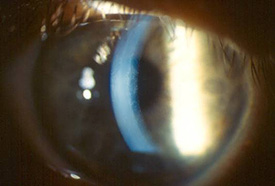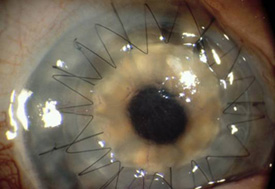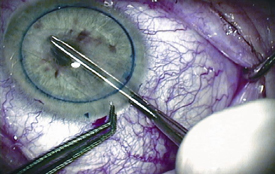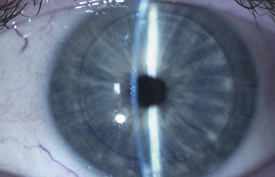Fuchs' Dystrophy
 Fuchs’ dystrophy is a progressive disease that affects the cornea, the clear dome that covers the iris (the colored part of the eye) and helps focus light as it enters the eye.
Fuchs’ dystrophy is a progressive disease that affects the cornea, the clear dome that covers the iris (the colored part of the eye) and helps focus light as it enters the eye.
With this disease, cells in the cornea’s inner layer, called the endothelium, are reduced in number. This causes the remaining cells to swell or thicken. The loss of endothelial cells can also allow abnormal dewdrop-shaped growths called guttata to form.
These cell changes may cause the cornea to become cloudy and swollen. Because Fuchs’ dystrophy is a progressive disease, the changes to the cornea can interfere with vision over time. Fuchs’ dystrophy usually occurs in people after age 40. Studies show that it is an inherited condition.
Symptoms of Fuchs’ dystrophy include hazy or cloudy vision that develops in stages. In the first stage, as the cornea swells, vision in the morning may be hazy, but it clears up during the day. Once the disease has progressed to a more advanced stage, vision no longer clears, and instead, you may experience pain and sensitivity to light.
It can take up to 20 years or longer for Fuchs’ dystrophy to progress from its earliest stage to a stage that is visually or physically significant.
Treatment
 In its early stage, Fuchs’ dystrophy is treated with saline
eye drops to pull excess fluid from the cornea or by using a hairdryer to help dry the surface of the cornea.
In its early stage, Fuchs’ dystrophy is treated with saline
eye drops to pull excess fluid from the cornea or by using a hairdryer to help dry the surface of the cornea.
As Fuchs’ dystrophy advances, you may be given a therapeutic bandage contact lens to lessen your discomfort.
If vision loss begins to interfere with your life in the latter stages of the disease, a corneal transplant technique known as penetrating keratoplasty may be performed. This procedure has an excellent success rate. This was the standard treatment in the past of corneal failure from Fuchs' dystrophy where the transplant involved a full thickness transplant of the cornea.


Recently a new procedure has been developed where only a thin piece of corneal tissue from the inside surface is transplanted. This procedure is called DSAEK (Descement's Stripping Automated Endothelial Keratoplasty). This new surgery involves a smaller incision, fewer stitches and heals much faster. Instead of 12 to 18 months a normal corneal transplant takes to heal a DSAEK heals in 3 to 4 months. Initial results have been very favorable but this is a newer procedure and the long term results have not been fully studied.
